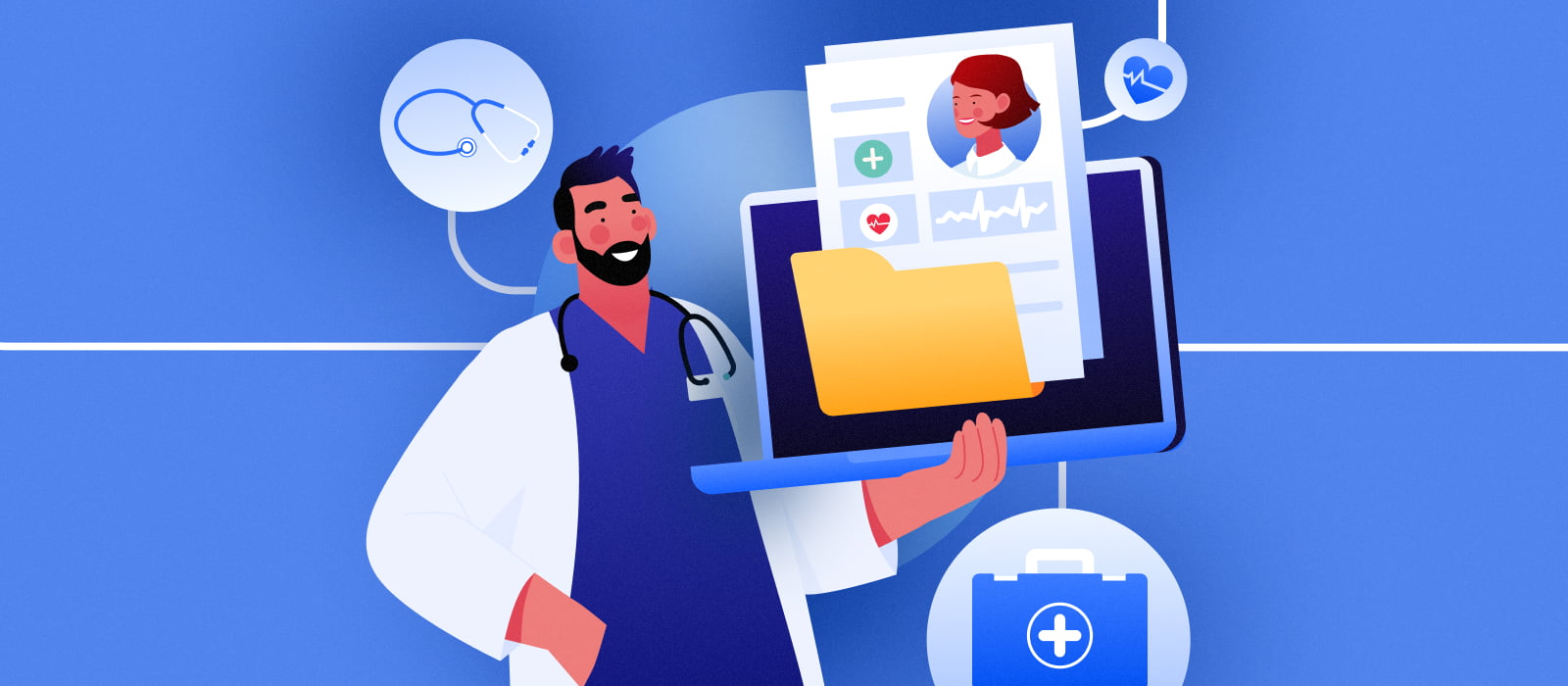The COVID-19 pandemic has done much to bring about healthcare digitization, with electronic health record (EHR) systems emerging as a major priority.
Recent research indicates that the global market for electronic health records reached $24,83 billion in 2021. It is projected to reach $52.98 billion by 2027. These figures suggest that EHR systems are well on their way to transforming the medical industry.
In this article we will look at EHR solutions and find out what makes them such a valuable asset to any medical facility. We will also provide you with a list of technologies used in EHR development and a step-by-step plan on how to build your own EHR system.
What is an EHR system?
An electronic health record system stores the digitized medical data of a patient. These include:
- Medical record
- Vaccination and allergies history
- Test results
- Lab data
- Prescribed medication
- Insurance information
What types of EHR are there?
There are two types of EHR systems: physician-hosted and remotely-hosted.
With physician-hosted systems, the data is stored on the physicians’ servers. In this scenario, the clinic is responsible for purchasing the necessary hardware and software and for its ongoing maintenance.
Meanwhile, servers of remotely-hosted EHR are located outside the medical facility. The clinics collect their data, but its management, including its maintenance and security, is the responsibility of the system’s third-party provider.
What’s the difference between EMR and EHR?
Aren’t electronic medical records (EMR) the same thing as EHR? Although they seem similar at first glance, there are some critical differences.
An EMR is a digitized patient chart stored in a hospital’s database. Doctors develop individual EMRs which are restricted to the practice. While there are some clear benefits, notably tracking data records and keeping abreast of patients’ therapies and overall health, EMRs are not shared amongst healthcare practitioners. This means that having a stack of EMRs is inconvenient if other physicians are to examine a patient.
For its part, EHR keeps records about a patient in a single file and shares information between numerous doctors and healthcare providers. Healthcare professionals working in different locations or countries can handle the same EHR — a vital element in decision-making, especially in critical situations.
What are the benefits of an EHR system?
Now that we’re familiar with EHR systems, let’s examine the benefits they provide to the three main stakeholders: healthcare providers, patients, and organizations.
Healthcare providers
Efficiency gains: Every patient’s information is instantly available, thus making it easier for doctors to receive test data, administer medicine, and track a patient’s medical history.
Secure and reliable: Well-designed EHR systems include automatic session termination, digital signatures, encryption, and multi-factor authentication. Thanks to this highly robust security, software hacking is impossible. Moreover, there are backups for system breakdowns. As a result, all files can be restored, and losing them is very unlikely.
Patients
Access to key data: All electronic health record systems have a user-friendly patient platform that gives patients access to their medical records, test results, and insurance papers.
Enhanced doctor-patient communication: EHR applications are essential in improving patient interactions with doctors and healthcare facilities. For instance, they simplify and expedite the administrative processes around appointments, hospitalization and the like.
Organizations
Potential market prospects: The EHR market does not operate on a ‘one size fits all’ basis. Regardless of geography or scale, every healthcare organization has unique EHR software requirements, meaning there is always room for developing new business models.
A range of monetization options: EHRs, like any other software, have several monetization models, ranging from subscription to free software with paid features to pay-per-use. Because of the variety of monetization options, investing in EHR system development is highly attractive.
Take a look at Doctime — a healthcare platform making booking doctor appointments an easy and comfortable experience
What are the key features of EHR platforms?
![]()
Although each electronic health record solution is designed to meet the medical facility’s unique functionalities and needs, there are several key features shared by all EHR systems:
Patient portal
Each EHR will have a patient portal. There, users can find information such as a patient’s name, age, medical records, allergies, lab tests, medication, and more. The patient portal is accessible to all parties involved: doctors, lab technicians, and patients themselves.
Lab integration
Integration of EHR and test labs promises faster data exchange. As a result, labs will know exactly which tests to run, patients will be informed about the pre-test preparation, and the doctors will receive the correct results.
E-prescription management
Doctors can use the e-prescribing function to administer medications remotely. What’s more, they will be able to check patients’ medical data to guarantee no drug incompatibility. In addition, patients can keep track of their medication history.
Invoicing
The operation of any healthcare facility revolves around invoices, claims, denials, and payments made for services. The EHR system simplifies these procedures by automating the invoicing process. Furthermore, many of these systems also have payment features that allow patients to pay directly for their treatments.
Document management
Electronic health record systems make document management much easier, allowing patients and doctors to upload papers in a number of different formats, such as picture, text, and DICOM (the format for MRT and CT images).
EHR software can also be enhanced with speech recognition, helping users to fill in the prescriptions and other records without delay.
Need an efficient document management tool? Get acquainted with DocTime — a blockchain-based paperwork management solution
Data access mechanisms
An EHR system must have numerous data access control mechanisms, so that only entitled specialists can get access to sensitive patient data. For example, nurses and lab technicians should not have access to the same data as doctors, unless they have been granted permission by the physician.
What is HIPAA compliance and why is it necessary for an EHR system?
HIPAA stands for ‘Health Insurance Portability and Accountability Act’, a mandatory compliance standard in the US. It ensures insurance coverage and maintenance.
HIPAA mandates 75 security protocols, and paragraph §164.312 addresses technical aspects of EHR software development. But most importantly, the primary goal of HIPAA compliance is to protect PHI (patient health information).
HIPAA Compliance in EHR Software Development encompasses the following:
- Regulations concerning privacy and security
- Document administration
- Employee training
- Plans for emergencies or incidents
- Management of vendors and businesses
All healthcare providers must ensure that their data processing approach satisfies all HIPAA obligations. This is especially important when managing digital records, as they may become a target of fraudsters.
What is the tech stack for EHR software?
There are several technologies necessary to build a robust electronic health record system:
- Languages: Java, Python, PHP, Swift, Kotlin, JavaScript
- Databases: MySQL, PostgreSQL
- Analytics: Google Analytics, Optimizely, Amazon EMR
- Frameworks and libraries: Django, Node.js, Bootstrap, Angular, jQuery
- Utilities: Microsoft Azure, Amazon S3, Cloudflare
- Web server: Apache HTTP Server, nginx
- Payment gateway: Stripe, Braintree, PayPal
How to build an EHR system?
Implementing an EHR is a multi-step process. Having a solid plan can save hours of stress for everyone involved. So what does a step-by-step roadmap look like?
![]()
Step 1. Validate your idea
First of all, you need to check the validity of the idea by doing thorough market research. How will your EHR be different from other solutions? What components of the system are most likely to yield an instant payoff? Which aspects of the healthcare system will benefit the most from EHR automation? These questions can be your compass as you explore what your competitors are doing and work out what features can set you apart.
Step 2. Design and develop the solution
Next, designers can work out the UI/UX of the solution based on business analysis data and market research.
Once the design is approved, software developers take it forward. They will turn the concept into a fully-fledged solution, implementing all the necessary features of the future EHR system. They may have to integrate such technologies as AI, IoT, or even blockchain.
Step 3. Perform testing
When the EHR system is ready, it goes through quality assurance. Testers thoroughly check all the components, and mimic various possible scenarios to determine that the solution won’t crash. They also validate security compliance to make sure the system is tamper-proof.
Step 4. Launch the solution
When your electronic health record solution is bug-free and conforms to security standards, it is ready for launch. As it will be distributed across different medical facilities, your task will be to provide timely maintenance and gather feedback for further upgrading.
Want to know more about software testing? Read our article where we explain quality assurance process in detail
Closing thoughts
Electronic health record systems promise to revolutionize the healthcare industry, bringing such advantages as seamless document management, improved security, and simplified patient-doctor communication. They will also be of great help to patients who cannot attend physical medical facilities in person.
We are excited to see the future development of EHR technology and will be thrilled to build one. Our seasoned professionals provide comprehensive healthcare software development services and have vast expertise in such fields as AI, IoT, blockchain, cloud computing, and more.
Drop us a line and our custom software development services specialists will help you create a next-gen healthcare solution!




